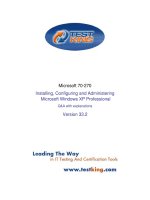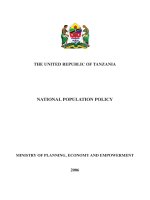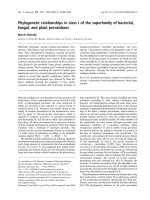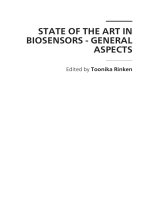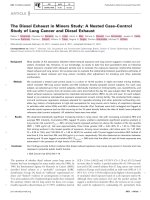Validation of Communications Systems with SDL: The Art of SDL Simulation and Reachability Analysis pptx
Bạn đang xem bản rút gọn của tài liệu. Xem và tải ngay bản đầy đủ của tài liệu tại đây (3.56 MB, 311 trang )
Simpo PDF Merge and Split Unregistered Version -
Validation of Communications
Systems with SDL
Simpo PDF Merge and Split Unregistered Version -
Simpo PDF Merge and Split Unregistered Version -
Validation of Communications
Systems with SDL
The Art of SDL Simulation and Reachability
Analysis
Laurent Doldi
TransMeth Sud-Ouest, France
Simpo PDF Merge and Split Unregistered Version -
Copyright 2003 John Wiley & Sons Ltd, The Atrium, Southern Gate, Chichester,
West Sussex PO19 8SQ, England
Telephone (+44) 1243 779777
Email (for orders and customer service enquiries):
Visit our Home Page on www.wileyeurope.com or www.wiley.com
All Rights Reserved. No part of this publication may be reproduced, stored in a retrieval system or
transmitted in any form or by any means, electronic, mechanical, photocopying, recording, scanning or
otherwise, except under the terms of the Copyright, Designs and Patents Act 1988 or under the terms of a
licence issued by the Copyright Licensing Agency Ltd, 90 Tottenham Court Road, London W1T 4LP, UK,
without the permission in writing of the Publisher. Requests to the Publisher should be addressed to the
Permissions Department, John Wiley & Sons Ltd, The Atrium, Southern Gate, Chichester, West Sussex PO19
8SQ, England, or emailed to , or faxed to (+44) 1243 770620.
This publication is designed to provide accurate and authoritative information in regard to the subject matter
covered. It is sold on the understanding that the Publisher is not engaged in rendering professional services. If
professional advice or other expert assistance is required, the services of a competent professional should be
sought.
Other Wiley Editorial Offices
John Wiley & Sons Inc., 111 River Street, Hoboken, NJ 07030, USA
Jossey-Bass, 989 Market Street, San Francisco, CA 94103-1741, USA
Wiley-VCH Verlag GmbH, Boschstr. 12, D-69469 Weinheim, Germany
John Wiley & Sons Australia Ltd, 33 Park Road, Milton, Queensland 4064, Australia
John Wiley & Sons (Asia) Pte Ltd, 2 Clementi Loop #02-01, Jin Xing Distripark, Singapore 129809
John Wiley & Sons Canada Ltd, 22 Worcester Road, Etobicoke, Ontario, Canada M9W 1L1
Wiley also publishes its books in a variety of electronic formats. Some content that appears
in print may not be available in electronic books.
British Library Cataloguing in Publication Data
A catalogue record for this book is available from the British Library
ISBN 0-470-85286-0
Typeset in 10/12pt Times by Laserwords Private Limited, Chennai, India
Printed and bound in Great Britain by Antony Rowe Ltd, Chippenham, Wiltshire
This book is printed on acid-free paper responsibly manufactured from sustainable forestry
in which at least two trees are planted for each one used for paper production.
Simpo PDF Merge and Split Unregistered Version -
To my parents
To Martine
To Elsa
Simpo PDF Merge and Split Unregistered Version -
Simpo PDF Merge and Split Unregistered Version -
Contents
Preface xi
Foreword xiii
1 Introduction 1
1.1 Validation of Communications Systems 1
1.2 SDL, Language to Master Complex Systems Development . . 2
1.2.1 Overview of SDL . 2
1.2.2 Benefits provided by SDL 3
1.3 Simulation Life Cycle 4
1.4 Contents of the Book 6
1.5 Tools and Platforms Used 7
2 Quick Tutorial on SDL 9
2.1 Structure of an SDL Model 9
2.1.1 System, block and process 9
2.1.2 Scope of declarations 10
2.1.3 Process 10
2.1.4 Procedure 11
2.2 Communication 11
2.2.1 Signals 11
2.2.2 Channel 13
2.2.3 Signal route 13
2.3 Behavior 13
2.3.1 Structure of a transition 13
2.3.2 Start 14
2.3.3 States 15
2.3.4 Input 15
2.3.5 Save 16
2.3.6 Variables 17
2.3.7 Stop 17
2.3.8 Task 17
2.3.9 Create 18
2.3.10 Output 18
2.3.11 Decision 19
2.3.12 Timers 19
2.4 Data Types 20
Simpo PDF Merge and Split Unregistered Version -
viii Contents
2.4.1 Predefined data . 20
2.4.2 Array 21
2.4.3 Synonym and syntype . 21
2.4.4 Newtype . 21
2.5 Constructs for Better Modularity and Genericity 22
2.5.1 Package 22
2.5.2 Types, instances and gates 22
2.5.3 Specialization 24
3 The V.76 Protocol Case Study 25
3.1 Presentation 25
3.2 Specification of the V.76 Protocol 26
3.2.1 Abbreviations used 26
3.2.2 Exchange identification procedures (XID) 27
3.2.3 Establishment of a data link connection 27
3.2.4 Information transfer modes 28
3.2.5 Release of a DLC 28
3.3 Analysis MSCs for the V.76 Protocol 28
3.4 The SDL Model of V.76 30
3.4.1 The simulation configuration of V.76 30
3.4.2 The package V76 30
3.4.3 The block dataLink . 35
4 Interactive Simulation 39
4.1 Principles 39
4.2 Case Study with Tau SDL Suite . 40
4.2.1 Prepare the Simulator 40
4.2.2 Validate against the main scenarios 44
4.2.3 Detect a bug in the SDL model 50
4.2.4 Detect nonsimulated parts 55
4.2.5 Validate against more scenarios 58
4.2.6 Write a script for automatic validation 62
4.2.7 Other Simulator features 63
4.3 Case Study with ObjectGeode 68
4.3.1 Prepare the Simulator 69
4.3.2 Validate against the main scenarios 75
4.3.3 Detect a bug in the SDL model 79
4.3.4 Detect nonsimulated parts 86
4.3.5 Validate against more scenarios 88
4.3.6 Write a script for automatic validation 93
4.3.7 Other Simulator features: watch, trace, filter etc. . 95
4.4 Errors Detectable by Interactive Simulation 108
4.4.1 Dynamic errors detected by Tau SDL suite Simulator 108
4.4.2 Dynamic errors detected by ObjectGeode SDL Simulator 109
4.4.3 Dynamic errors not checked 110
5 Automatic Observation of Simulations 111
5.1 Principles 111
Simpo PDF Merge and Split Unregistered Version -
Contents ix
5.1.1 Automatic checking of model properties 111
5.1.2 Specificity of observation with MSCs in Tau SDL Suite 113
5.2 Case study with Tau SDL Suite 114
5.2.1 Simulate with user-defined rules 114
5.2.2 Simulate with a basic MSC 117
5.2.3 Simulate with an MSC containing inline operators 119
5.2.4 Simulate with an HMSC 121
5.2.5 More details on MSCs 127
5.2.6 Simulate with observer processes . 132
5.2.7 More details on observer processes 134
5.3 Case Study with ObjectGeode . 136
5.3.1 Simulate with stop conditions 136
5.3.2 Simulate with a basic MSC 139
5.3.3 Simulate with a hierarchical MSC 142
5.3.4 More details on MSCs 149
5.3.5 Simulate with GOAL observers 159
5.3.6 More details on GOAL observers 161
6 Random Simulation 167
6.1 Principles . 167
6.2 Case Study with Tau SDL Suite 167
6.2.1 Random simulation without observers 167
6.2.2 Multiple random simulations 169
6.2.3 Random simulation with observers 170
6.3 Case Study with ObjectGeode . 172
6.3.1 Random simulation without observers 172
6.3.2 Multiple random simulations 174
6.3.3 Random simulation with observers 175
6.3.4 Details on random simulation 179
6.4 Errors Detectable by Random Simulation 180
7 Exhaustive Simulation 181
7.1 Introduction . 181
7.1.1 Exhaustive simulation 181
7.1.2 Bit-state simulation 184
7.1.3 On-the-fly validation 184
7.2 Simple Examples . 185
7.2.1 Exhaustive simulation of the ping TCP/IP command 185
7.2.2 Exhaustive simulation of counters 190
7.3 Case Study with Tau SDL Suite 191
7.3.1 One second to detect missing save of v76frame 192
7.3.2 One second to detect missing input L
ReleaseReq 197
7.3.3 One second to detect missing input L
DataReq 199
7.3.4 Millions of states: detect output to Null 202
7.3.5 Forty seconds to detect missing save of L
DataReq 206
7.3.6 Two minutes to detect missing input L
ReleaseReq and answer DM 210
7.3.7 Three minutes, 6.7 million states, no error 214
7.3.8 Bit-state simulation with a user-defined rule 217
Simpo PDF Merge and Split Unregistered Version -
x Contents
7.3.9 Verifying an MSC with bit-state simulation 218
7.3.10 Bit-state simulation with observer processes 220
7.4 Case Study with ObjectGeode 221
7.4.1 One second to detect missing save of v76frame 221
7.4.2 One second to detect missing input L
ReleaseReq 225
7.4.3 One second to detect missing input L
DataReq 227
7.4.4 Seventeen seconds to explore 87174 global states . 230
7.4.5 Add faults in block dataLink : detect output to Null 235
7.4.6 Twenty-two seconds to detect missing save of L
DataReq 240
7.4.7 Eleven minutes to detect missing input L
ReleaseReq
and answer DM 243
7.4.8 Eleven minutes, 2.8 million states, no error 248
7.4.9 Exhaustive simulation with stop conditions 250
7.4.10 Exhaustive simulation with MSC observers 251
7.4.11 Exhaustive simulation with GOAL observers 253
7.5 Other Simulation Algorithms 256
7.5.1 Tau SDL Suite 256
7.5.2 ObjectGeode: supertrace 256
7.5.3 ObjectGeode: liveness 257
7.6 Strategy to Master Exhaustive Simulation 262
7.6.1 Which simulation modes should be used 262
7.6.2 If simulation never terminates 263
7.7 Errors Detectable by Exhaustive Simulation 264
7.7.1 Errors detected by Tau SDL Suite 264
7.7.2 Errors detected by ObjectGeode 265
8 Other Simulator Features 267
8.1 Tau SDL Suite 267
8.1.1 Writing in the Simulator trace 267
8.1.2 Calling external C code 267
8.1.3 Simulating ASN.1 data types 270
8.1.4 Adding buttons to the Simulator . 270
8.1.5 Adding buttons to the Validator 272
8.1.6 Setting breakpoints in the Simulator . 272
8.1.7 Running several communicating Simulators 273
8.1.8 Real-time simulation . 275
8.1.9 List of Validator options 275
8.2 ObjectGeode 279
8.2.1 Writing in the Simulator trace 279
8.2.2 Calling external C code 279
8.2.3 Simulating ASN.1 data types 281
8.2.4 Adding buttons to the Simulator . 281
8.2.5 Simulation scheduling like in Tau SDL Simulator and Validator 282
8.2.6 List of Simulator settings 284
Bibliography 289
Index 293
Simpo PDF Merge and Split Unregistered Version -
Preface
This book is the second in a series; after a first book explaining SDL (Specification and
Description Language) and about how to build an SDL model [Doldi01], this book explains how
to validate the model by simulation. The two books share the same SDL case study, a simplified
version of V.76, a protocol standardized by the ITU (International Telecommunications Union).
I have written this book because, after using ObjectGeode
and Tau SDL Suite (both
from Telelogic) for more than ten years, I felt that the numerous powerful features available in
such SDL tools needed to be clearly explained to a wide audience, instead of being confined
to severe technoweenies.
Readers who want to practise the exercises described in the book must contact the SDL tool
vendors (see their updated list on www.sdl-forum.org), who generally provide free licenses for
evaluation or cheap licenses for universities.
The first versions of ObjectGeode and Tau SDL Suite including a simulator, named Geode
and SDT at that time, have been released around 1989. However, to my knowledge, 13 years
after that release, this is the first book published on validation of SDL systems by simulation.
Very few other commercial tools or languages provide such a range of features for the
validation and development of communications systems and software.
Some may question the need for this book, as the SDL tools have their own documentation.
The answer is that the documentation of each tool, assuming one of your colleagues has not
taken it away, contains thousands of pages, which is not always organized to present first the
basic simulation notions and then to introduce progressively more advanced features. In the
book, every notion presented is illustrated by a hands-on systematic example, which has been
actually executed on the two simulation tools, with direct explanations.
Although this book describes how to validate telecommunication systems, it can be used to
validate the behavior of other kinds of real-time systems that can be modeled by communicating
state machines.
I hope that this book will reveal to students or managers the power of SDL simulation, and
will help designers and developers in the validation of their SDL models.
Laurent Doldi
Simpo PDF Merge and Split Unregistered Version -
Simpo PDF Merge and Split Unregistered Version -
Foreword
‘Better’, ‘faster’ and ‘cheaper’ are the master words nowadays: how to build the best product,
spend less and finish in time. Every project manager knows this triptych: every time she or he
starts a new project, it could turn into a nightmare. CMM-I, Six Sigma, COCOMO II, MDA,
MDD, XML and others are answers that have resulted from different industries involving the
development of complex systems.
Modeling techniques have had significant quality and productivity impact in domains ranging
from business processes to embedded real-time applications. The Unified Modeling Language
(UML), Model Driven Architecture (MDA), Component Based Development (CBD), Use Case
Maps, Message Sequence Charts (MSCs), and Specification and Description Language (SDL)
all support modeling concepts that help reduce the impedance mismatch between models of the
problem domain and designs in the solution domain.
Programming languages are no longer the necessary and sufficient condition to success. All
effort is put in product development to better manage the process. Requirement management,
system and software architecture, and model development are part of the artifacts of a good
system or software development process.
Simulation, one of the most acclaimed requirements to UML 2.0, helps software engineers
who simulate the software architecture as well as its design for a better verification and valida-
tion of what is being built. Simulation can only be based on a formal language with a clearly
defined syntax and semantics. Formal abstract languages such as SDL and the upcoming UML
2.0, are the answers for modelers with concerns such as verifying architecture models and
design models.
Why simulate? What to simulate? How to simulate Answers to these questions are found
in this book, which is a result of the vast experience Laurent Doldi has acquired in the more
than two decades during which he was involved as a consultant engineer, in complex system
engineering, in tool development and in teaching classes. Whether your concern is verification or
validation, you will find in this book a systematic and practical approach aimed at engineers. It
will guide you through the use of tools to perform simulation, architecture or design debugging
by getting coverage of your requirements expressed as test cases using MSCs, meet your quality
expectations and get a faster return on investment not only for the tools but also during product
development.
Jamel Marzouki
Distinguished Member of the Technical Staff, Motorola Labs, Schaumburg, IL
Simpo PDF Merge and Split Unregistered Version -
Simpo PDF Merge and Split Unregistered Version -
1
Introduction
1.1 VALIDATION OF COMMUNICATIONS SYSTEMS
Communications systems and software are more and more difficult to develop: they include
complex features such as wireless and mobile access, under strong constraints such as low size,
weight or power consumption, interworking, total interoperability, security, short time-to-market
and low cost.
Respecting such an array of constraints requires a high quality of the specifications or
standards used for their development. This is why the specifications of many communica-
tions systems are based on SDL (Specification and Description Language) or at least contain
SDL parts describing complex behaviors. Examples of such systems are the GSM second-
generation mobile telephony system, the UMTS third-generation mobile telephony system, the
ETSI HiperLAN 2 Broadband Radio Access Network or the IEEE 802.11 wireless Ethernet
local area network.
Validation of such systems by simulation of SDL models is useful, for example, at the
following stages:
• when standards are created by the organizations, to check that the behavior of the system
is correct, to generate Message Sequence Charts (MSCs) (sequence diagrams) illustrating
typical use cases, or to generate TTCN (Tree and Tabular Combined Notation) test cases to
test the conformance of future implementations;
• before the implementation of a standard by a company, because standards rarely contain a
finished SDL model ready to be translated into the application code;
• to provide nonambiguous low-error specifications to a contractor, enabling a quicker and less
expensive implementation;
• after changes in the specifications, to check that the system has not regressed.
During all these stages, the simulation allows the detection of specification or design-level
anomalies, preventing them to be embedded in the implementation. Once the code is loaded
into a target device embedded into a complex test environment, each error detected is more
difficult and expensive to analyze than during an SDL model simulation: the error can come
not only from the specification but also from the coding, from the testing environment, from
the hardware and so on.
Also, SDL simulation enables the execution of the specification before the target hardware
and software platform is available: board, board support package, compiler and so on.
Validation of Communications Systems with SDL: The Art of SDL Simulation and Reachability Analysis.
Laurent Doldi
2003 John Wiley & Sons, Ltd ISBN: 0-470-85286-0
Simpo PDF Merge and Split Unregistered Version -
2 Validation of Communications Systems with SDL
The SDL Simulators, especially in exhaustive mode, quickly find error scenarios far beyond
human imagination: bugs that could appear after millions of devices have been sold, revealed
by a modification of their environment, can be detected and fixed during the specification or
design phase.
Concerning safety-critical systems such as fault-tolerant aircraft systems architectures, medi-
cal or car devices, the validation by simulation can prove formally that their specified behavior
is correct, according to a set of criteria.
1.2 SDL, LANGUAGE TO MASTER COMPLEX SYSTEMS DEVELOPMENT
1.2.1 Overview of SDL
SDL stands for Specification and Description Language. It is standardized by the ITU (Inter-
national Telecommunication Union) in the Z.100 Recommendation [SDL00, SDL99].
In SDL-92
1
, the architecture is modeled as a system containing blocks, as depicted in
Figure 1.1. Each block may contain either blocks or processes. Each process contains an
extended finite state machine. State machines communicate by exchanging signals through
channels (or signal routes).
system TCP_IP
block TCP
process pr1
state
machine
pr1
block IP
process pr2
TCP
IP
pr2
ch1 [sig1]
[sig2]
[sig2]
[sig1]
sr5
sr8
[sig2]
[sig1]
sig2
sig1
closed
listen
idle
ready
queue
queue
Figure 1.1 Schematic view of an SDL-92 description
Signals (sig1 or sig2 in Figure 1.1) arriving on a state machine are queued. By consum-
ing a signal from its queue, a state machine executes a transition from one state to another
state. During the execution of a transition, a wide range of actions can be performed by a
state machine: signal transmission to another state machine, assignment, procedure or operator
call, loop, process instance creation and so on. The execution semantics of SDL is accurately
described and includes the semantics of actions in state machine transitions.
Data types are described using predefined types or constructs such as Integer, Boolean,
Character, struct, Array, String, Charstring, Powerset. ASN.1 can be used in an SDL model
1
SDL-92 means the 1992 version of SDL plus the corrections introduced in Addendum 1 to Recommendation Z.100
of 1996, sometimes called SDL-96.
Simpo PDF Merge and Split Unregistered Version -
Introduction 3
to describe more complex data types, using constructs such as choice (similar to union in C),
optional fields, Bitstring or Octetstring and providing standardized encoding rules.
SDL is object-oriented: it provides the notions of classes, inheritance, polymorphism (in
SDL-2000) and so on found in object-oriented programming languages.
SDL is frequently used with MSCs, similar to UML (Unified Modeling Language) Sequence
Diagrams.
1.2.2 Benefits provided by SDL
SDL being a graphical language enables you to visually design models, instead of using only a
textual notation. SDL provides graphical structuring features (blocks, etc.), state machines and
communication through signals that are not available in programming languages such as C++
or Java.
During the modeling process and after its completion, and because SDL has a complete
semantics, the SDL description can be rapidly checked and debugged using the powerful
tools available today (see Figure 1.2), namely the compilers and simulators, enabling very
fast model correction.
SDL
Editor
SDL
description
SDL
Compiler
Simulator
Validator
Test Case
Generator
C Code
Generator
errors
dynamic
errors
TTCN
test suite
application
(.exe, …)
covered by [Doldi01] covered by this book
Figure 1.2 Life of an SDL description
Bugs are found and corrected before the implementation begins. SDL simulators provide high
caliber debugging features, from symbol by symbol stepping to automatic simulations using
various strategies (random, exhaustive, bit-state, supertrace etc.) coupled to automatic error
detection by observers. Simulation scripts allow automatic nonregression testing of the SDL
description in a few seconds by automatic replay of scenarios, with observers on-line checking
the SDL behavior. Simulators generate MSCs representing a visual trace of the simulation.
After testing the SDL description, code generators can autocode it: it is not necessary to write
a single line of code to get the application running, except when communicating with non-SDL
parts or optimizing performance if severe constraints exist. Just by pressing a button, a code
generator produces, without manual coding errors, one or several binaries running on one or
several computers or boards, without executive or under Unix, win32, Posix
, VxWorks,
VRTX
, Chorus, PSOS and so on. Execution on the target system produces a visual trace
in the form of MSC sequence diagrams.
Also, test cases in TTCN or in another test language can be generated by very sophisticated
tools, ranging from transformation of an interactive simulation scenario into TTCN to automatic
generation of TTCN test cases covering all SDL symbols or automatic generation of TTCN
test cases corresponding to user-defined test purposes.
Simpo PDF Merge and Split Unregistered Version -
4 Validation of Communications Systems with SDL
1.3 SIMULATION LIFE CYCLE
The life cycle of simulation can be split into three steps, as illustrated in Figure 1.3:
1. Production of an SDL model ready for simulation, starting either from a textual specification,
as in the V.76 case study presented in the book, or from an SDL model, for example coming
from a protocol standard, or from legacy code that must be reverse-engineered because no
useful specification documents exist;
2. Interactive simulation, offering a good level of validation and automatic nonregression test-
ing;
3. Exhaustive simulation, the top level in validation, reserved for safety-critical or cost-critical
systems. Cost-critical means that leaving errors in the system would be very expensive,
because its code will be embedded into millions of devices.
Simulation produces a low-default executable specification, plus reference MSCs (sequence
diagrams) that provide an excellent documentation and which can be used as test cases to test
the system implementation: as they have been generated by simulation, they are consistent with
the validated SDL model.
create
simulatable
SDL model
interactive
simulation
textual spec.
or
SDL model
or
legacy code
exhaustive
simulation
low-default
executable
SDL spec.
reference
MSCs
12
3
Figure 1.3 The three simulation steps
Step 1 is shown in Figure 1.4: if an SDL model exists for the system, it must be compiled.
If there are errors, the SDL model must be corrected. Some SDL models may need to be com-
pleted, for example to add missing data type declarations. If no SDL model exists, a decision
must be taken to use or not to use SDL: if the system is not complex or not safety-critical,
such an investment is not necessary. Beware of systems that seem to be simple but are not, in
terms of behavior. Then, if the system (or a part of it) cannot be modeled using extended finite
state machines communicating with signals through queues (a kind of mailbox), use another
language, such as a synchronous language. Otherwise, continue with Step 2.
Step 2 is shown in Figure 1.5: first, the main scenarios (the use cases) are simulated step by
step. Each scenario is stored (files .scn, .com or .cui) to be replayed automatically later. Each
MSC trace is also stored. When an error is found, the SDL model (or an specification if it is
wrong) is corrected.
To detect automatically when the SDL model is wrong or when it is correct, observers can be
created. Then the SDL model is simulated together with its observers, replaying the scenarios
stored previously, to check that the observers work correctly. Again, when an error is found,
the SDL model is corrected.
To replay scenarios automatically, scripts can be written: after each model correction or
evolution, all the test scenarios are automatically replayed in a few seconds and the simulator
reports any error or any violation detected by the observers.
Simpo PDF Merge and Split Unregistered Version -
Introduction 5
SDL model
exists?
yes
SDL model
compilable?
yes
no
correct the
SDL model
no
system is complex
or safety-critical?
no
yes
can be modeled
by communicating
state machines?
no
yes
do not
use SDL
create the
SDL model
interactive simulation (2)
1. SDL model creation
Figure 1.4 Step 1: SDL model creation
simulate the
main scenarios
save scenarios
and MSC traces
create observers
simulate with
observers
create scripts for automatic
scenarios replay
errors?
yes
no
correct the
SDL model
errors?
yes
no
correct the
SDL model
exhaustive simulation (3)
safety or
cost-critical?
no
yes
end of simulation
2. Interactive simulation
Figure 1.5 Step 2: interactive simulation
Simulation detects SDL symbols never executed: more scenarios must be created to try to
cover them.
If the system is not safety- or cost-critical, this level of simulation is sufficient. Otherwise,
continue with Step 3.
Step 3 is shown in Figure 1.6: exhaustive (or bit-state) simulation is run. When an error or
an observer violation is found, the SDL model (or an observer) is corrected. The scenarios
Simpo PDF Merge and Split Unregistered Version -
6 Validation of Communications Systems with SDL
run exhaustive (or
bit-state) simulation
keep scenarios
and MSC traces
errors?
yes
no
correct the
SDL model
all states
explored?
yes
no
reduce
max. queue
length etc.
end of partial
validation
configuration
can be reduced?
no
yes
end of
formal proof
3. Exhaustive simulation
Figure 1.6 Step 3: exhaustive simulation
generated by the simulation must be kept, together with the MSC traces of the scenarios that
satisfy the observers.
If all the reachable states of the SDL model have been explored, the simulation is fin-
ished: the SDL model correctness has been formally proved (according to the configura-
tion used).
Otherwise, because the large number of global states prevents exploring them, the model
configuration must be reduced, for example, by allowing one or two signals only per pro-
cess input queue, limiting the exploration depth and so on. If the configuration cannot be
reduced, the simulation is finished, and the validation is partial because some global states
remain unexplored.
The simulator also detects SDL symbols never simulated: they indicate SDL transitions or
branches that could be removed, or reveal missing test signals or test values to be transmitted
to the SDL model by the simulator.
All these steps are detailed in the book, illustrated by numerous hands-on exercises.
1.4 CONTENTS OF THE BOOK
This book is divided into eight chapters. Chapter 1 is the present introduction. Chapter 2 is
a quick tutorial on SDL-92, the language used for the exercises in the rest of the book.
Chapter 3 contains the simplified version of the V.76 protocol specification, some analysis
MSCs and the corresponding SDL model used during the simulation exercises. Chapter 4
explains how to validate the V.76 SDL model using interactive simulation. Chapter 5 introduces
observers, what they can detect, how to build them and how to use them during interactive
simulation. Chapter 6 describes random simulation. Chapter 7 presents exhaustive simulation,
how to use it with observers and other simulation algorithms such as bit-state or liveness.
Chapter 8 illustrates other simulator features such as calling external C code or adding buttons
to the simulators.
Simpo PDF Merge and Split Unregistered Version -
Introduction 7
Each chapter contains hands-on exercises with solutions for the two main SDL tools com-
mercially available: ObjectGeode and Tau SDL Suite, both from Telelogic.
1.5 TOOLS AND PLATFORMS USED
The exercises of the book have been developed using the following commercial off-the-shelf
tools, both developed by Telelogic
2
:
• ObjectGeode Version 4.2 for Windows
• Tau SDL Suite Version 4.0 for Windows
The Unix versions of these tools are very similar to their Windows version. The main difference
is the way they are launched: it is generally performed by double clicking on an SDL file in
Windows and by typing a command in Unix.
The V.76 SDL model used in the book and its associated files can be downloaded in
ObjectGeode and Tau SDL Suite formats on />2
ObjectGeode has been developed by Verilog, with France Telecom R&D (former CNET) know-how. Then, in 1999,
Telelogic has acquired Verilog.
Simpo PDF Merge and Split Unregistered Version -
Simpo PDF Merge and Split Unregistered Version -
2
Quick Tutorial on SDL
For readers not familiar with SDL, this chapter presents the most frequently used constructs of
SDL-92. A detailed step-by-step tutorial on SDL-92 [SDL92] and a presentation of SDL-2000
are provided in [Doldi01].
2.1 STRUCTURE OF AN SDL MODEL
2.1.1 System, block and process
SDL provides the following entities to structure a description:
• system: top level, outermost construct;
• block: must be contained in the system or in a block;
• process: must be contained in a block;
• service (optional): must be contained in a process;
• procedure (optional): can be placed anywhere.
Figure 2.1 shows an example of a system containing three blocks.
system syst1
DLCaSU
(su2dlc)
(dlc2su)
DLCaDL
(V76frames)
(V76frames)
DLCbDL
(V76frames)
(V76frames)
DLCbSU
(su2dlc)
(dlc2su)
block3
block2
block1
Figure 2.1 System syst1
Figure 2.2 shows that block1 contains two blocks.
Figure 2.3 represents the contents of block1
1 and block3. Block1 1 contains one process,
and block3 contains two processes. The state machines contained in processes (or services)
instances communicate together or with the environment by transmitting and receiving signals
(or remote variables or procedures) through channels and signal routes.
Validation of Communications Systems with SDL: The Art of SDL Simulation and Reachability Analysis.
Laurent Doldi
2003 John Wiley & Sons, Ltd ISBN: 0-470-85286-0
Simpo PDF Merge and Split Unregistered Version -
10 Validation of Communications Systems with SDL
block block1
DLCaSU
DLCaDL
ch1
(su2dlc)
(dlc2su)
ch3
(V76frames)
(V76frames)
ch2
sig1
block1_1
block1_2
Figure 2.2 Block block1
block block3
DLCaDL DLCbDL
fromA
(V76frames)
toB
(V76frames)
fromB
(V76frames)
toA
(V76frames)
process3_1 process3_2
block block1_1
ch1
ch3
ch2
dlcSU
(su2dlc)
(dlc2su)
dlcDL
(V76frames)
(V76frames)
sr1
sig1
process1_1
Figure 2.3 Blocks block1 1 and block3
2.1.2 Scope of declarations
A declaration is used to define signals, data types, variables and so on. In SDL, a declaration
is visible in the current entity and its children. For example, a signal declared in the system is
visible in the whole system. Variables cannot be declared in a block or in a system; therefore
global variables do not exist in SDL.
2.1.3 Process
A process, if it does not contain any service, contains a state machine. Figure 2.4 shows a
process in which the variable V76par has been declared. A variable is local to a process and
thus is not visible, for example, from another process. Our process contains only one state, ready.
Each process has one or more instances, running in parallel, and independent. Two numbers
are used to specify the number of instances for a process:
• the first number indicates the initial number of instances (when the system is started),
• the second number indicates the maximum number of instances running at a certain moment.
Figure 2.5 depicts the two main possibilities for the number of instances.
Each process instance contains four implicit variables:
• self : c ontains the Pid of the current instance,
Simpo PDF Merge and Split Unregistered Version -

